In the world of watches, the three-letter acronym “GMT” that stands for “Greenwich Mean Time” hardly needs further explanation.
For enthusiasts, it may as well mean “grand, magnificent, and timeless” for it offers the convenience of indicating two time zones on one dial. While today we can see all 36 time zones from every cell phone, that doesn’t diminish the joy of a dual time zone timepiece.
With today’s busy schedule including business and leisure travel, this complication is highly sought after. And it has a long tradition.
The division of the world into time zones started at the International Meridian Conference in Washington, D.C. in 1884, where what we often slangily call GMT – it is in actuality Coordinated Universal Time (UTC) – was set up to aid rail and naval navigation at a time when international travel was beginning.
This modern system of standardized time that divides the world into zones was the brainchild of railway engineer Sir Sandford Fleming (1827-1915). His ingenious system, still in use today, established Greenwich, England at 0 degrees longitude as the standardized starting point for the division of the world into what was then 24 time zones.
After missing several train connections in Ireland due to am/pm mix-ups, he came up with the idea of a single 24-hour clock for the world. Universal Time, as it became known, was pretty much globally accepted by 1929.
Although the expression “GMT” was officially replaced by Coordinated Universal Time (UTC) in 1960, it has remained to serve as a synonym for timepieces with a second time zone to this day.
In modern times it is often combined with other complications like chronographs and implemented in all types of timepieces – from pilots timepieces to divers and tool watches.
Here are three no-nonsense pieces that each represent the sophistication of GMT timekeeping in their very own way. Enjoy their classic travel-time designs pared down to the essential.
Blancpain Villeret GMT Date: elegantly straightforward
The Blancpain Villeret line has rich history, unique horological know-how, and beautifully expressed aesthetic style.
The collection is distinguished by the sleek lines of its double-stepped cases, high-end manufacture calibers, and understated dials with expressively detailed, elegantly curved Roman numerals that seem like tiny sculptures.
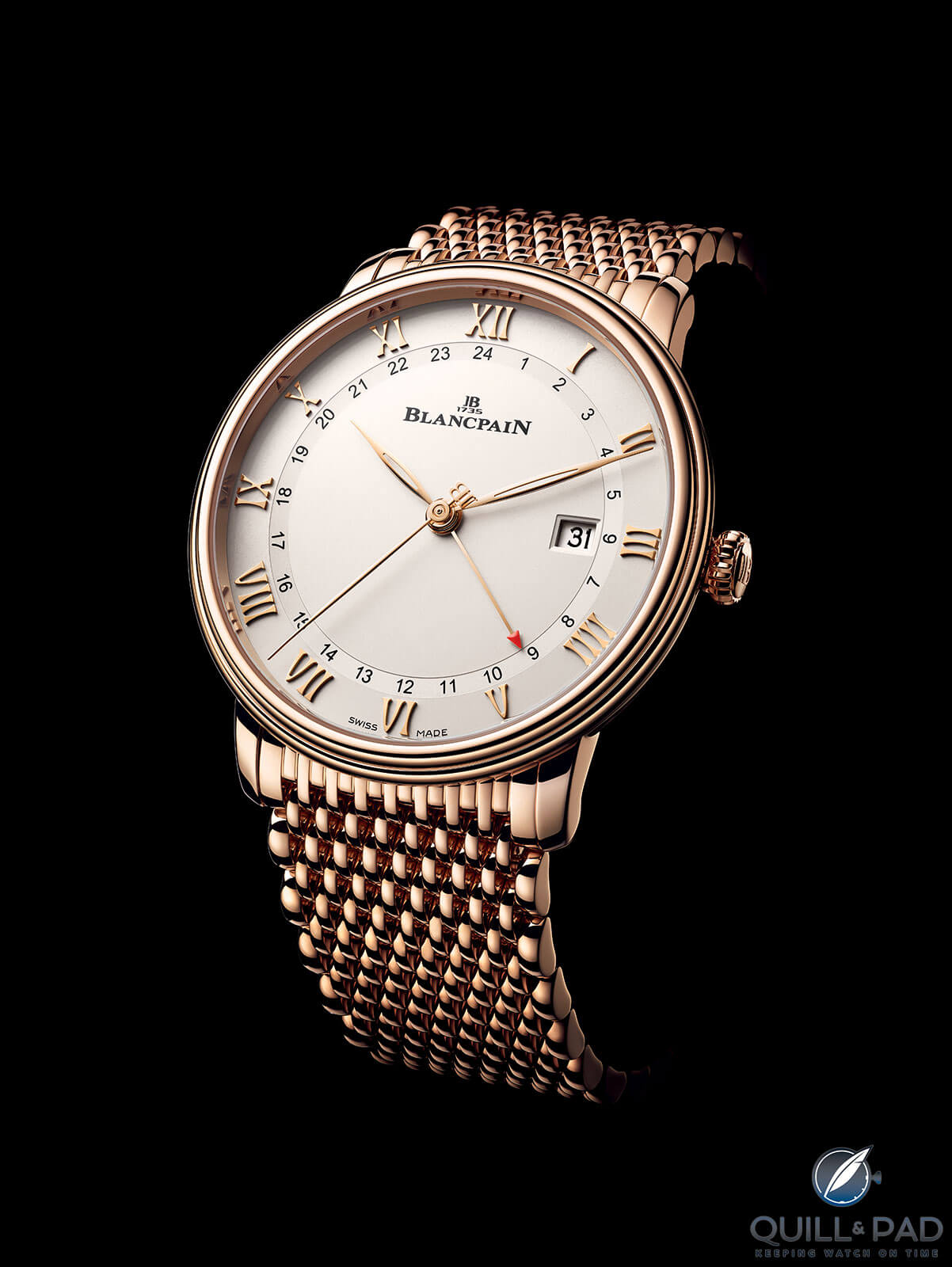
Blancpain Villeret GMT Date in gold on a gorgeous Mille Mailles bracelet
This rings especially true for the Villeret GMT Date that launched as the collection’s first classic GMT model at the Swatch Group’s Time to Move event in May 2019.
The 40 mm timepiece available in pink gold or stainless steel with an opaline white dial displays the beloved Villeret style in the best sense. In combination with a case height of 10.28 mm, the sleek and minimalist appearance makes for a picture-perfect dress watch.
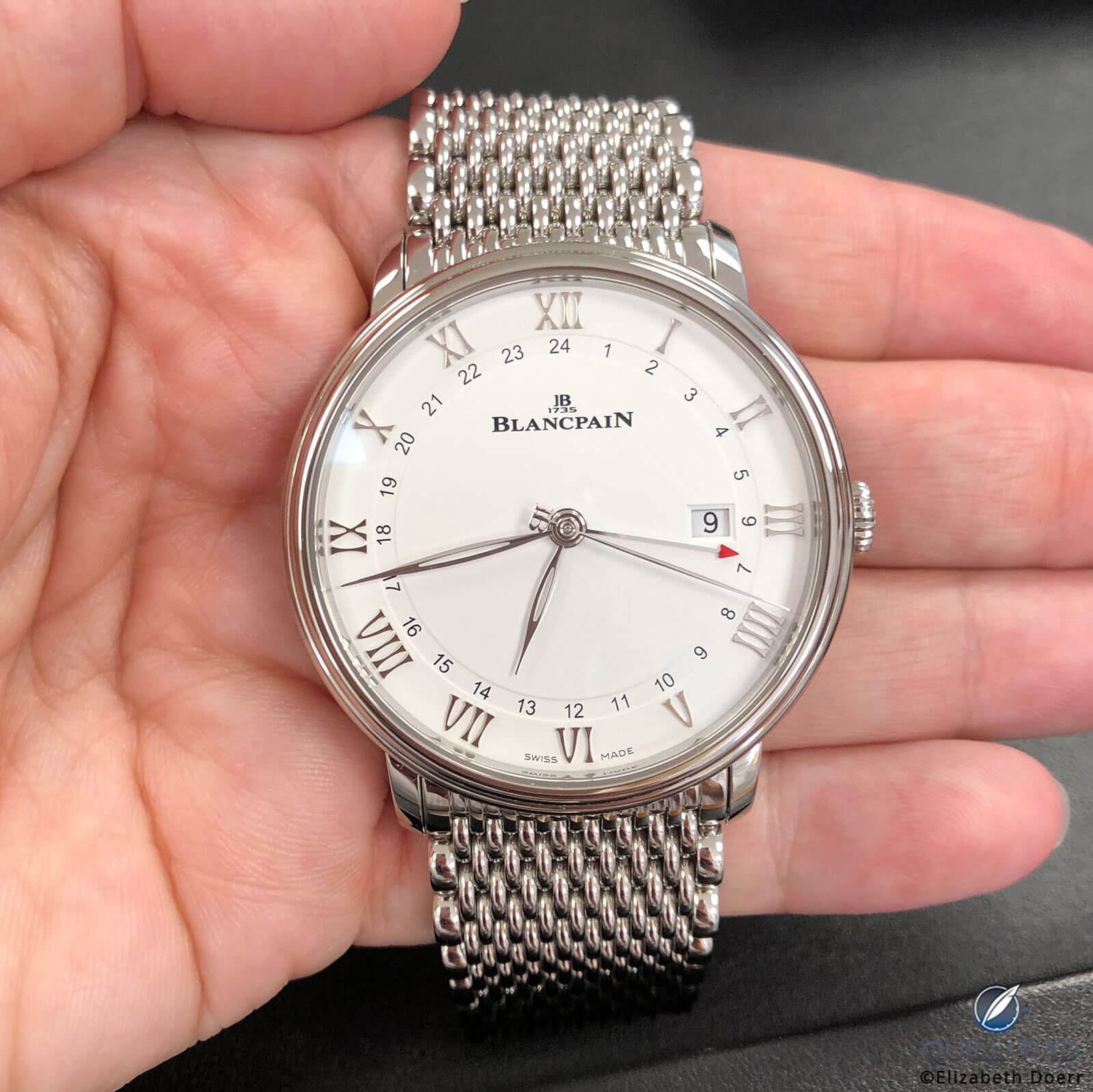
Blancpain Villeret GMT Date in stainless steel
In addition, it offers a refined and easy-to-read layout that allows the observer to see the two time zones at one glance. While the travel time using the beautiful Villeret Roman numerals takes center stage, the reference or home time is displayed on a small 24-hour scale and indicated by a red-tipped hand.
And the mechanism is very convenient too: fast GMT (second time zone) correction, the date, and the time are all adjusted via the crown.
As is the case with all Blancpain watches, the Villeret GMT Date is powered by a manufacture movement offering state-of-the art technology: automatic Caliber 5A50, which offers a full 100 hours of power reserve, is equipped with a cutting-edge silicon balance spring.
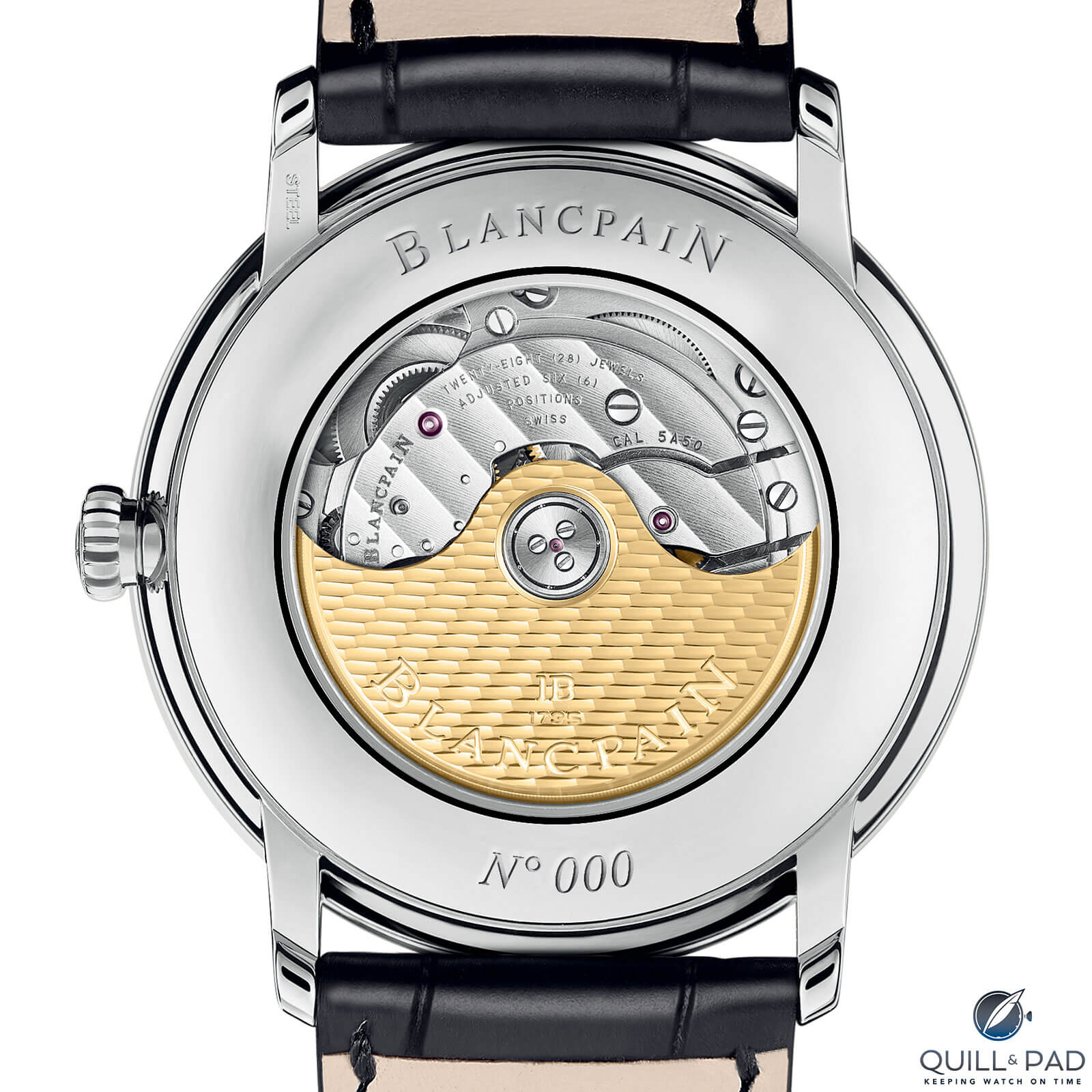
Blancpain Villeret GMT Date’s Caliber 5A50
This manufacture movement has been decorated and finished to the highest standards. The sapphire crystal case back displays a striking vista with the rotor’s honeycomb guilloche taking the spotlight.
And, last but hardly least, I must mention the extraordinary Mille Mailles bracelet that is an option with Villeret GMT Date: a silky, sensuous piece of horological jewelry that must be felt to be believed.
For more information, please visit www.blancpain.com/en/villeret/gmt-date.
Quick Facts Blancpain Villeret GMT Date
Case: 40 x 10.8 mm, red gold or stainless steel
Movement: automatic manufacture Caliber 5A50, 3 Hz/21,600 vph frequency, 100-hour power reserve, silicon balance spring
Functions: hours, minutes, seconds; date, second time zone
Price: stainless steel starting from CHF 11,200, red gold starting from CHF 18,700
Montblanc Heritage GMT: a contemporary take on vintage
Those following the development of Montblanc’s watches over the past 20 years have witnessed an extraordinary success story: its evolution into a full-blown haute horlogerie marque seems unparalleled in the recent history of watchmaking.
An important milestone on the way to becoming a full manufacture was the acquisition of the Swiss specialist Minerva in 2006. Since then, Montblanc has had access to a fine legacy in the field of complex and accurate short-term time measurement.
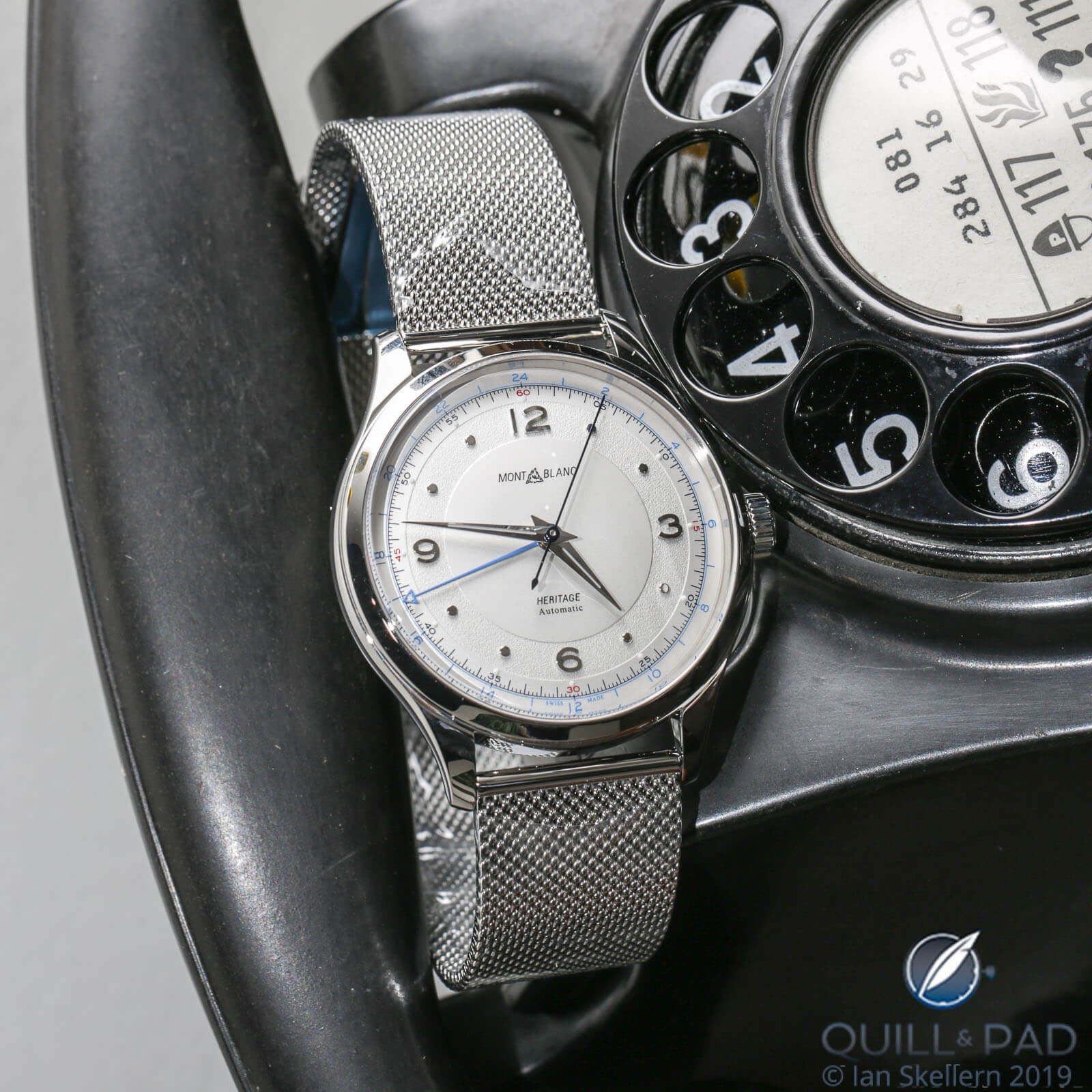
Montblanc Heritage GMT
In their heyday in the first half of the nineteenth century, Minerva chronographs, legendary for their high precision and innovative features, were staples at a variety of sporting events and races.
Capturing the best of Minerva’s design history and commitment to crafting superb timepieces, Montblanc presented a new lineup within its Heritage collection at the 2019 SIHH, including a perpetual calendar, a monopusher chronograph, an automatic day-date, a three-hander, and the Heritage GMT that is the subject of this section. See more in Montblanc 2019 Heritage Line: Minerva More Visible Than Ever. And That Is So, So Good.
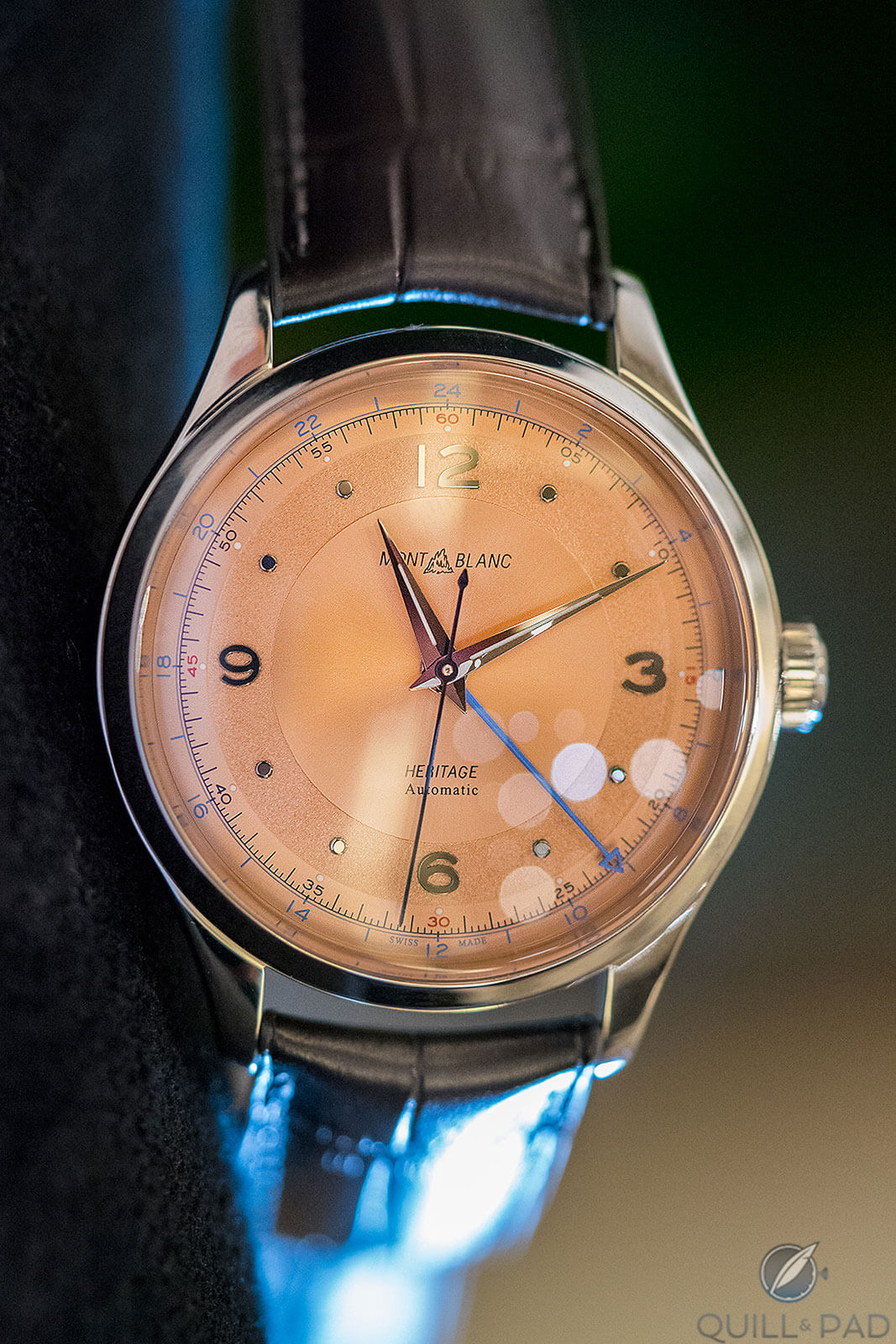
Montblanc Heritage Automatic GMT with salmon dial
All of these new timepieces are clearly inspired by Minerva’s legacy, displaying the vintage style of the 1940s and ’50s at its best while offering a decidedly fresh take on the design and overall quality.
These watches feature harmonious proportions, offering versions in 39 and 42 mm diameters. They boast slightly domed, retro-laden dials in elegant color schemes like white and blue as well as salmon and blue, with applied dots and Roman numerals as well as dauphine-style hands.
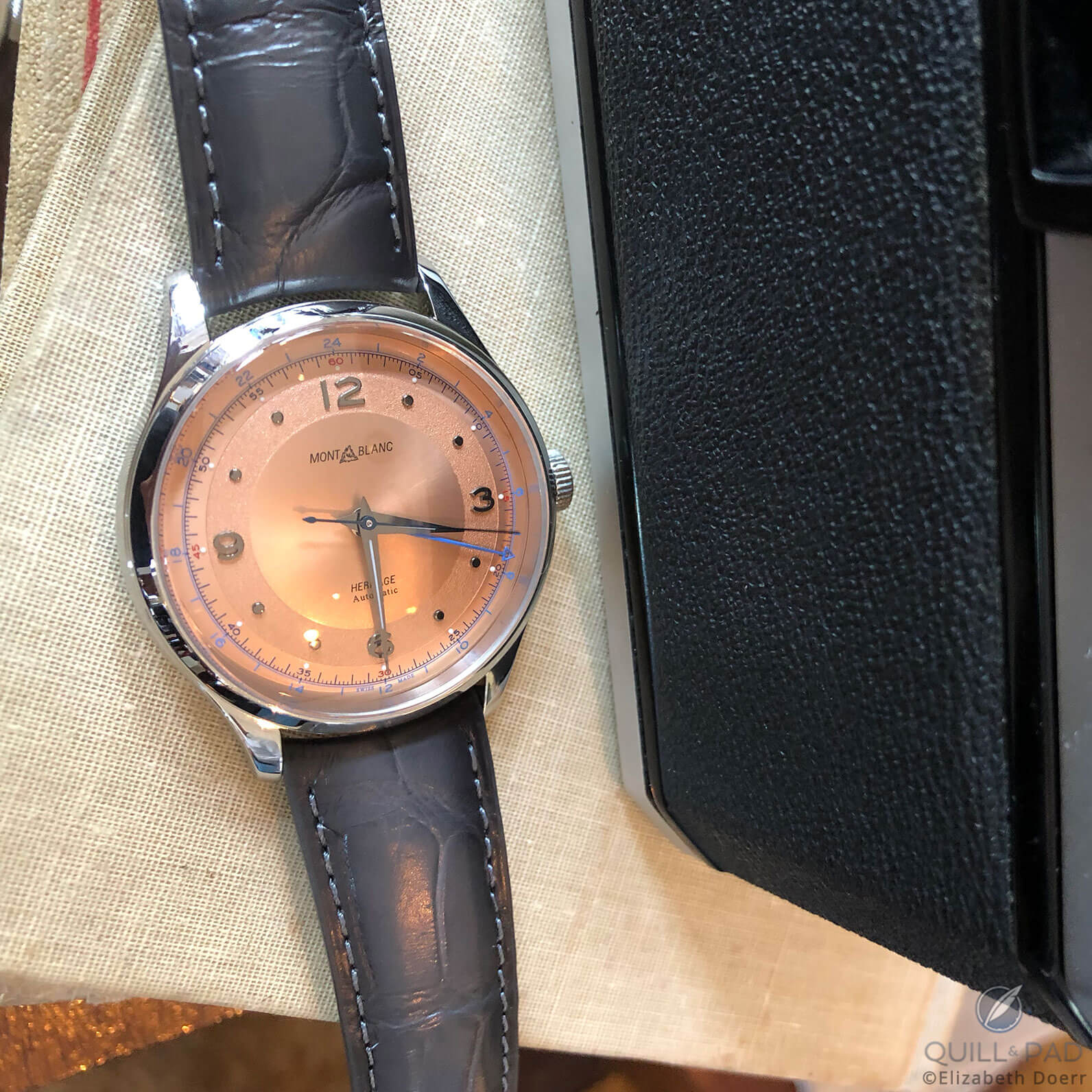
Montblanc Heritage Automatic GMT with salmon dial
The Heritage GMT sports a clear no-frills indication of the two times zones with the home time scale placed on the flange. Since the latter is displayed in 24-hour style, there is no need for an am/pm indication, which underscores the minimalist expression.
For more information, please visit www.montblanc.com/en-us/collection/watches/montblanc-heritage.
Quick Facts Montblanc Heritage GMT
Case: 40 x 11.65 mm, stainless steel
Movement: automatic Caliber MB 24.05 (base ETA 2893-2), 4 Hz/28,800 vph frequency, 42-hour power reserve
Functions: hours, minutes, seconds; second time zone
Price: $2,850 (grey Sfumato Montblanc alligator strap); $3,060 (stainless steel Milanese bracelet)
Porsche Design 1919 Globetimer UTC: ahead of the curve
If fans of the genre think that GMTs are “grand, magnificent, and timeless,” they might call Porsche Design’s new 1919 Globetimer UTC “uber, timeless, and very cool.” Undoubtedly the brand’s highlight at Baselworld 2019, the timepiece enjoyed a grand reception thanks to its clever time-zone mechanism operated via two pushers.
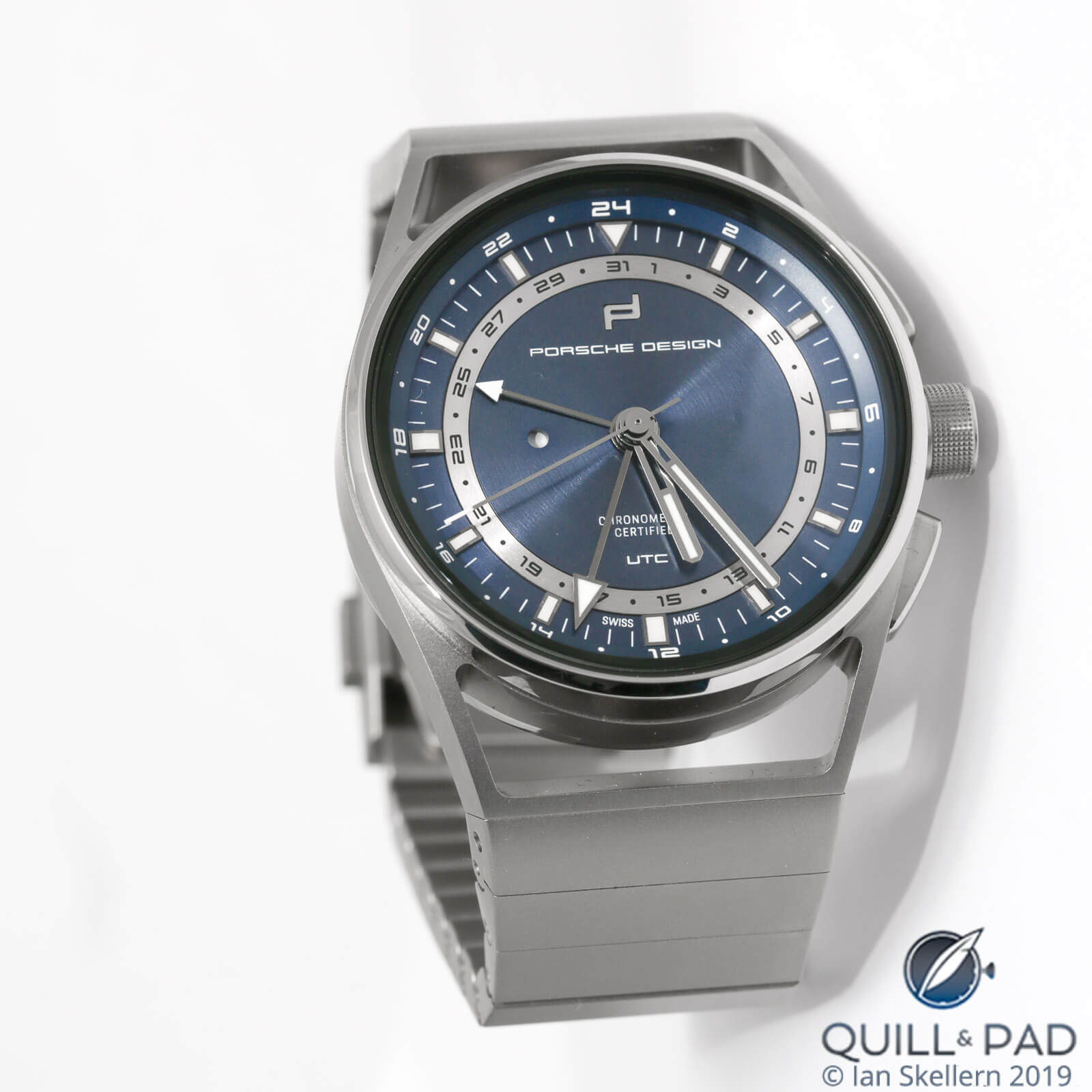
Titanium Porsche Design 1919 Globetimer UTS with blue dial on titanium bracelet
Offering an unbeatable combination of simplified user friendliness and unobstructed legibility of the two time displays, this superlative new GMT wristwatch embodies the credo of the legendary designer Professor Alexander Porsche, who insisted that a genuinely sophisticated design results from the underlying function.
Local time is easily set by the two pushers in one-hour increments, one adjusts the time forward and one backward. While that operation is taking place, the hours and minutes remain untouched and accurate at all times. A small day/night disk at 9 o’clock serving as an am/pm indicator helps the wearer select the correct local time.
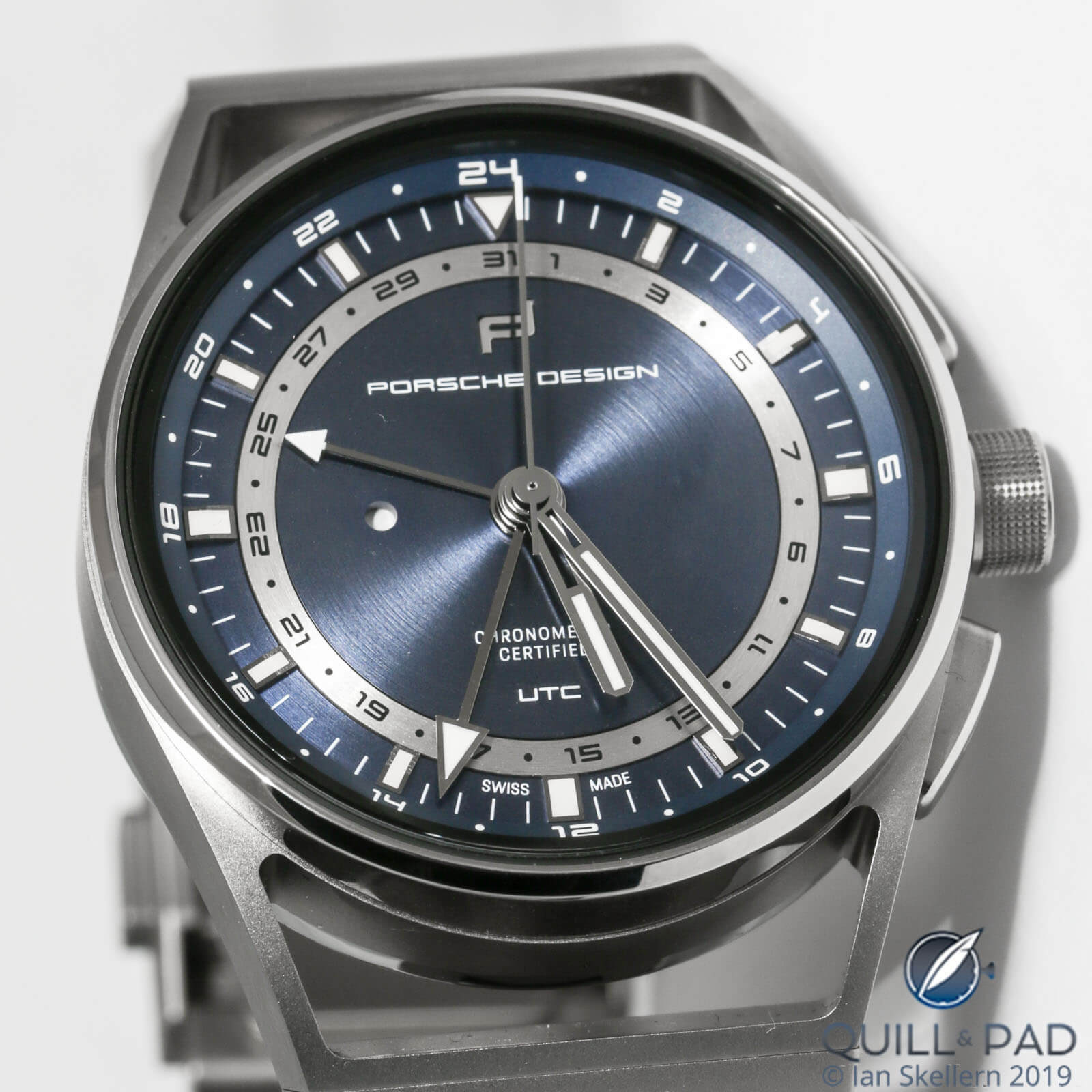
Porsche Design 1919 Globetimer UTS with its distinctive “framework” lugs and blue dial
Another nice feature is that the date hand is linked to the local time and automatically switches forward and backward when selecting the time zone. The local time is displayed on the outer perimeter of the wide and spacious dial that focuses on legibility – in true 1919 collection fashion.
The titanium case has a very slim allure despite being sporty and water resistant to 100 meters. The cut-out lugs typical of this line add to the lightweight appearance that is of course another principle of the brand highlighting the connection to the world of race cars.
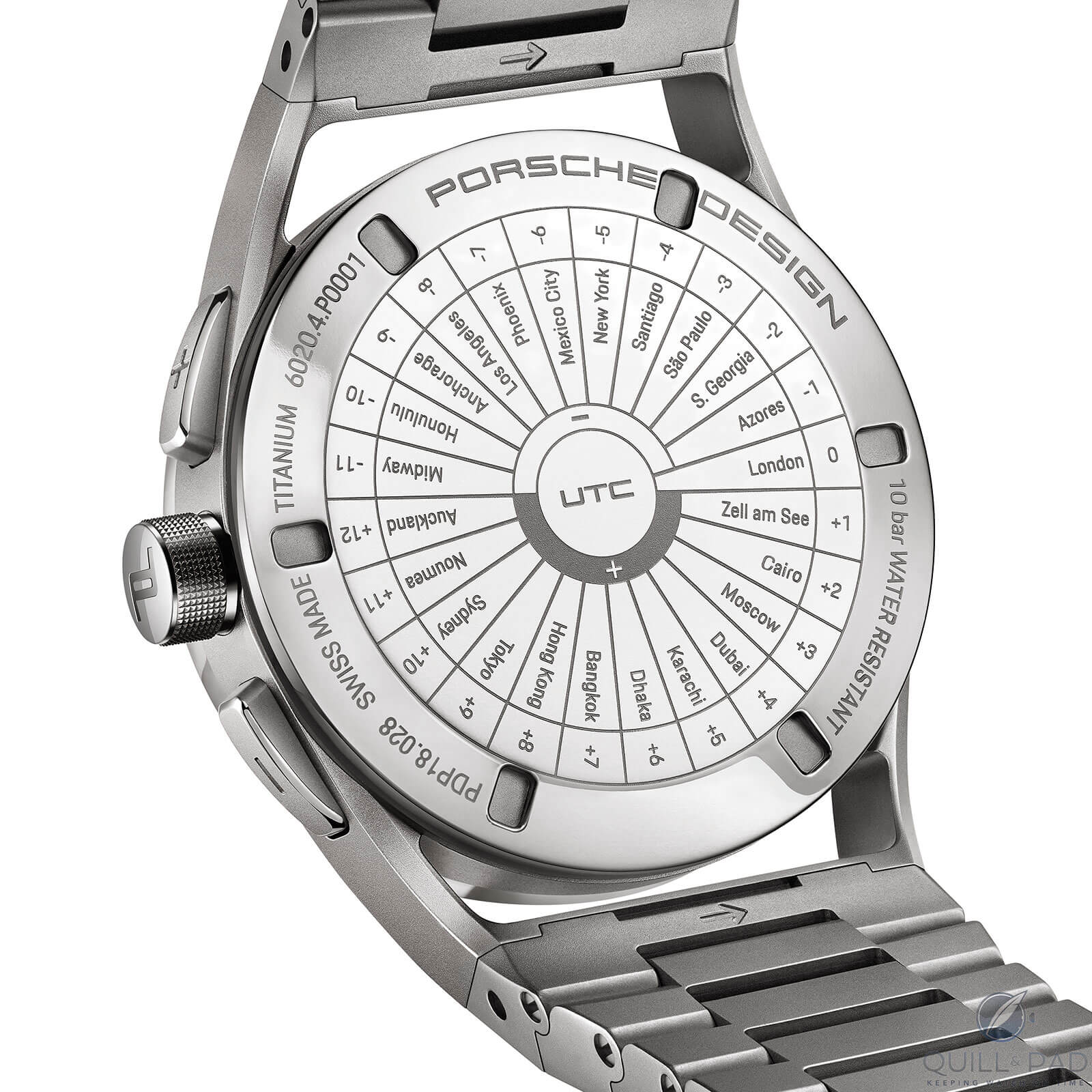
World time zones engraved on the back of the Porsche Design 1919 Globetimer UTS
As for the “motor,” Porsche Design’s C.O.S.C.-certified and Chronofiable-tested Caliber Werk 04.119 revs up behind the closed case back featuring an engraving of the world’s time zones. Based on a Sellita SW 200 movement, it sports a customized time-zone module by Dubois Dépraz that was specially developed for Porsche Design.
For more information, please visit www.porsche-design.com/en/Timepieces/1919-Collection/1919-UTC/Porsche-Design-1919-Globetimer-UTC-All-Titanium-Blue.
Quick Facts Porsche Design 1919 Globetimer UTC
Case: 42 x 14.9 mm, titanium
Movement: automatic Caliber Werk 04.110 (Sellita SW 200 base) with Dubois Dépraz GMT module, 4 Hz/28,800 vph frequency, 38-hour power reserve, officially certified C.O.S.C. chronometer, Chronofiable tested
Functions: hours, minutes, seconds; date, second time zone
Price: €6,450 on titanium bracelet
You may also enjoy:
Montblanc 2019 Heritage Line: Minerva More Visible Than Ever. And That Is So, So Good
Porsche Design 1919 Globetimer UTC: When The World Is Your Oyster
Blancpain Villeret Complet GMT: Classic Turns Travel Companion
Leave a Reply
Want to join the discussion?Feel free to contribute!





















































Porsche got the industrial look well executed (striking famikiar cords in the design team, obviously) and the watch seems really easy to use. The complication with pushers is great and differentiates from crown enabled guts.
But having 2 identical arrow hands for 2 very different indications is very confusing. It is like: we design for form follows function for 90% of the watch, and then we wrap up the 2 hands for date and gmt, that last minute of the last evening.
Case design speaks for elaborate (probably quite iterative) design work. The similarity of the 2 arrow hands for 2 very different functions speaks to me for a half way there exercise, at best. Devil is in the details.
I like that Mont Blanc!